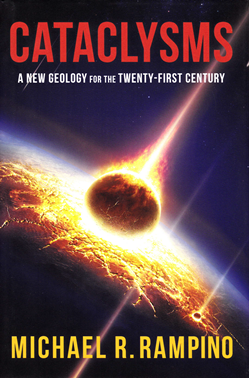
The debate between Catastrophism and Gradualism has swung back and forwards for 250 years. It involved many of the fathers of geology, not least Hutton, Cuvier, Dana and Lyell, and it provided a uniformitarian framework for Darwin’s ideas in the Origin of Species. It had been difficult to obtain evidence for extraterrestrial activity in the geological record, but this changed dramatically with the evidence for the impact structure of the Chicxulub Crater in 1990 and its links to the extinction of the dinosaurs.
Michael Rampino has long been interested in, and an advocate of, extraterrestrial processes in shaping the history of the Earth. The book is well written and easy to read, and it is personal in that it documents the development of his ideas and some of the research he himself undertook. It is engaging, but also verges on the adversarial in setting up Catastrophism versus Gradualism, when in the end it concludes that both may have been important in creating the geologic record we see today. Overall this book describes a journey as the author shrugs off what he regards as the shackles of Lyellian Gradualism, accepts the role of an impact in the mass extinction at the end of the Cretaceous, and explores what other aspects of the geological record might reflect extra terrestrial activity.
Much of the discussion of the role of extraterrestrial processes involves establishing that there are regular cycles, as in for example the timing of mass extinctions. Cyclical activity is a feature of the geological record and so one challenge is to distinguish those cycles that imply extraterrestrial activity. The case for periodicity in mass extinctions and its relationship to astronomical drivers is not new but it remains controversial.
More broadly there remains some unease in the matching of patterns of different changes with time, although this seems more acceptable in some disciplines than others. Perhaps geology is slow to adopt new models without some idea of the causes and mechanisms, and this may in part be why the take-up of continental drift was relatively slow. Cataclysms contains much discussion of the kinds of physical changes that might result from impacts, climate change, anoxia, acid rain, volcanic winters, but less on the biological consequences of environmental change on different species, which seems to be a key step in the argument. Perhaps it has yet to be established that different impact events are characterized by different effects on the fossil record that might in turn characterize the kinds of impacts involved.
The last chapter notes there is evidence for~30 Myr cycles related to changes in sea level, tectonics, palaeomagnetism, and discontinuities in sea-floor spreading rates. This is intriguing given that the periodicity suggested for extinctions is ~26 Myr. Every 30 Myr or so the Earth in its cosmic orbit is thought to pass through clumps of dark matter. Such matter could be a periodic source of energy, and Rampino ends with the speculation that this might be a way for the generation of 30 Myr cycles on the Earth to reflect extra terrestrial activity. It is a hypothesis that will continue to be discussed.
Reviewed by Chris Hawkesworth
CATACLYSMS – A NEW GEOLOGY FOR THE TWENTY-FIRST CENTURY by MICHAEL RAMPINO. Columbia University Press (2017) ISBN 9780231177801 224pp List Price (hbk or e-book): £27.95 W: https://cup.columbia.edu/book/cataclysms/9780231177801